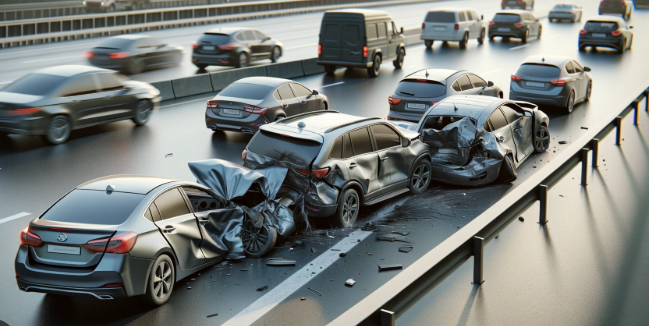
Chain collisions, or multi-vehicle accidents, are legally intricate due to the sequential nature of impacts and the potential involvement of multiple negligent parties. Determining liability hinges on identifying the proximate cause of the accident, assessing contributory negligence, and applying statutory frameworks. Below is a detailed analysis of the principles governing such cases, with a focus on Indian jurisprudence.
Key factors considered include:
- Which vehicle initiated the chain of collisions?
- Was there negligence or recklessness?
- Were there violations of traffic laws?
- Was there contributory negligence by others involved?
Courts assess liability based on negligence principles, proximate causation, and the statutory obligations under the Motor Vehicles Act, 1988.
Legal Principles Governing Liability
-
Negligence and Proximate Cause
The driver whose negligence initiated the chain reaction is typically held primarily liable, even if their vehicle did not directly collide with all affected parties. Courts apply the “root cause” doctrine, established in Royal Sundaram Alliance Insurance Co. Ltd. v. Honnamma & Ors. (2025), which states that the vehicle triggering the sequence bears liability for all resulting damages.“If an insured vehicle hits another vehicle which in turn hits a third vehicle, then for the entire chain of accidents, the liability would pass on to the vehicle which was the root cause of the accident.” — Supreme Court of India.
-
Statutory Framework (Motor Vehicles Act, 1988)
-
Section 166: Allows victims to claim compensation from the owner, driver, or insurer of the negligent vehicle.
-
Section 147: Mandates third-party insurance, ensuring coverage for bodily injury or death.
-
-
Contributory and Comparative Negligence
-
Contributory Negligence: If multiple drivers acted carelessly (e.g., tailgating, speeding), liability may be apportioned based on their degree of fault.
-
Comparative Systems: Some jurisdictions reduce compensation proportionally if the victim shares fault, though India primarily focuses on the root cause
Factors Influencing Liability Determination
Factor Explanation Legal Implications Initiating Vehicle The driver who caused the first collision (e.g., sudden braking, speeding). Primary liability for all subsequent damages. Contributory Actions Drivers who failed to maintain safe distances or react appropriately. Shared liability based on negligence. External Conditions Poor weather, road hazards, or faulty signage. Non-driver parties (e.g., contractors) may share liability. Insurance Coverage Compliance with statutory insurance requirements under the Motor Vehicles Act. Insurers of the root-cause vehicle bear liability. Case Study: Royal Sundaram Alliance Insurance Co. Ltd. v. Honnamma (2025)
-
Facts: A tractor driver’s rash driving caused a trailer to overturn, resulting in a fatality. The insurer contested liability, arguing the trailer was uninsured.
-
Supreme Court Ruling:
-
The insured tractor was the root cause, making its insurer liable despite the trailer’s lack of separate coverage.
-
Emphasized a victim-centric approach, prioritizing compensation over technical policy clauses.
-
Practical Scenarios and Liability Outcomes
-
Rear-End Chain Collisions
-
The vehicle initiating the collision (e.g., by tailgating) is typically fully liable unless pushed from behind.
-
Middle vehicles forced into collisions due to rear impacts are generally not at fault.
-
-
Sudden Stops Without Cause
-
A driver stopping abruptly without justification may share liability if it contributed to the chain reaction.
-
-
Adverse Weather Conditions
-
All drivers are expected to adjust speed and distance. Failure to do so can result in shared fault.
-
Conclusion
In chain collisions, liability primarily rests with the driver whose negligence triggered the sequence, as affirmed by India’s Supreme Court. However, contributory actions, statutory insurance mandates, and external factors can complicate fault allocation. The root cause doctrine ensures accountability aligns with causation, while victim welfare remains central to judicial interpretations. Legal practitioners must meticulously reconstruct events and apply these principles to secure fair outcomes for all parties.
-
-